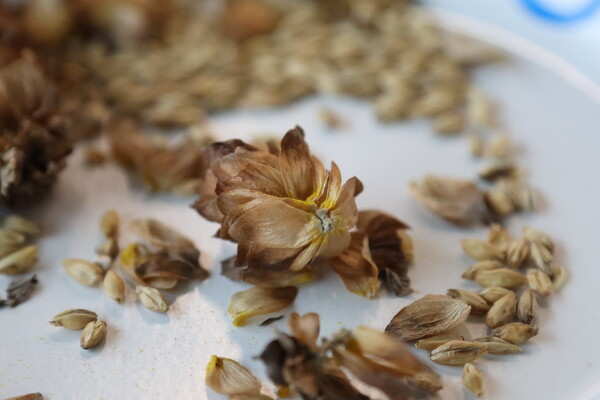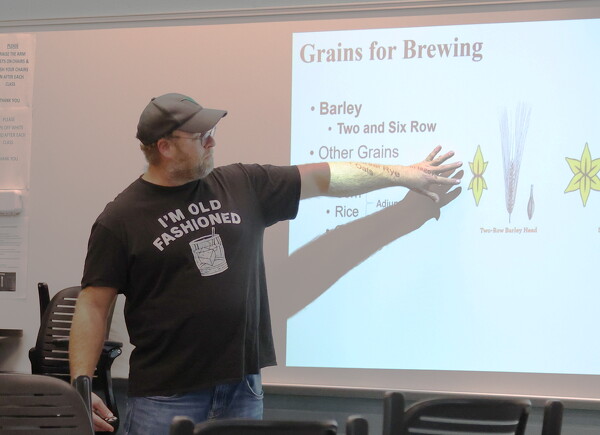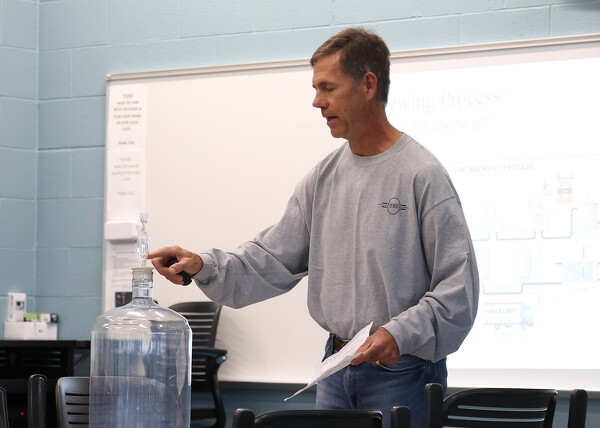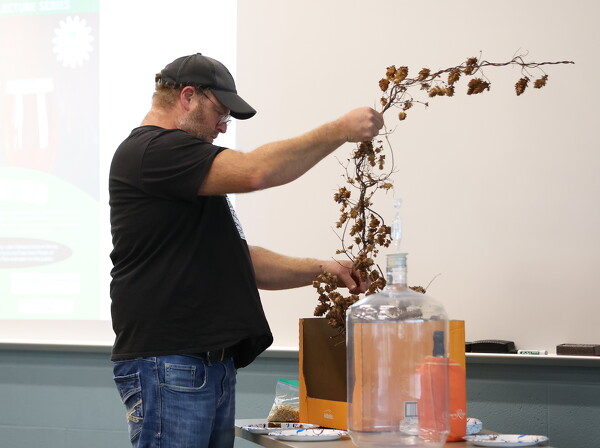Saturday, November 16th, 2024
Cheers for beers
Professors talk lagers, ales and what's in-between
By Erin Gardner

Photo by Paige Sutter/The Daily Standard
A plate of barley seeds and hops, two of the four main ingredients in beer.
CELINA - Not many things compare to a crisp, cold beer after a long week. In that beer are four ingredients, countless hours and centuries of practice.
A pair of Wright State University-Lake Campus professors on Friday laid bare the intricacies and science behind brewing beer at home.
The audience learned how grains, or barley, and hops are grown, processed and handled to make high-quality beer. The presentation, as part of the university's monthly lecture series, also included a brief overview of the brewing process.
Beer consists of four basic ingredients: water, grains or malt, hops and yeast. When combined in a specific process, the end product is a delicious beverage that has inspired an industry.
Assistant agriculture professor Greg McGlinch talked about the production side of brewing beer - planting and harvesting barley and hops.

Photo by Paige Sutter/The Daily Standard
Assistant agriculture professor Greg McGlinch explains the process of planting and harvesting barley and hops during a presentation at Wright State University-Lake Campus on Friday afternoon.
"I do produce the stuff at home. I am a home brewer, home distiller. I actually grow the product. I'll grind and make it myself," he said.
Malt is the principal source of fermentable sugar in beer, according to the American Homebrewers Association (AHA).
Raw, brewing-grade barley undergoes a germination and kilning process by malt manufacturers to prepare it for brewers. Simply, malt is barley that has been sprouted and dried.
"Every combination of roasting time, temperature, pH, concentration, sugar and nitrogenous compounds will create a different set of flavor chemicals in a malt," according to AHA. "Base malt refers to the majority of the malted grains used to make beer while specialty malts have a more dramatic impact on the flavor, mouthfeel, and color of the beer. Utilizing specialty malts is a relatively easy way to add more depth and character to extract brews."
McGlinch said he plants barley in September or October, during which the plant will remain dormant until April when it grows significantly.
The plant goes into a dormancy phase "where it just kind of shuts down and is chill."
"The thing with barley, especially these winter barleys, we'll plant them in the fall. You'll see there's a long period where nothing happens until April," he explained. "They go through dormancy, but they also go through a phase called vernalization. What the does is it induces reproduction in the plant. This is how our fruit crops and a lot of other plants that need the cold weather actually will propagate."
He will then harvest the plant in June or July and grind it down.
The summer is the toughest time to harvest any crop, McGlinch pointed out. The weather can prove challenging as precipitation, too much or too little humidity and wind can affect the plant.
"It's a balancing act. It's unique in that," he said.
Hops is the other key ingredient.
"Hops are the green, cone-shaped flower of the hop plant that are used to add balance, flavor and aroma to beer," according to AHA. "Hops contain specific amounts of alpha and beta acids, as well as essential oils broken down in boiling wort that give many beers their signature bitterness, flavor, and aroma."
Now that home brewers can grow their own barley and hops, they also need to know how to steep the grains into a mash, when to add yeast and how long to ferment the beer.

Photo by Paige Sutter/The Daily Standard
Economics professor Joseph Cavanaugh explains the process of brewing your own beer at home.
Economics professor Joseph Cavanaugh has been a home brewer for 33 years; he has the process down to a science.
"The way I brew now is much different that when I started," he said. "Home brewers can start off with really inexpensive (equipment). You can do it on your stove in your kitchen as long as you're very careful because you don't want to cause a big mess. You can buy liquid malt extract, so you can do it inexpensively, just buying a carboy and an airlock and having a big stockpot."
In either process, the basic idea is to extract the sugars from the grain so the yeast can turn it into alcohol and carbonation, Cavanaugh said.

Photo by Paige Sutter/The Daily Standard
Assistant agriculture professor Greg McGlinch shows hops.
The grains go through a process of heating and drying called malting. After malting the grains, the next step is mashing.
Mashing involves steeping the grains in hot water, similar to making tea. Mashing the grains brings out the sugar, which will later create alcohol and carbon dioxide with the help of some yeast.
After mashing, it's time to boil. This is the time when brewers can get creative by adding hops, spices and other flavorings. Different hops can add bitterness, spiciness or sweetness to the beer.
Once the hourlong boil is completed, it's time to add yeast and allow fermentation, Cavanaugh said. The beer is stored for weeks at a time, giving the yeast plenty of time to eat the sugar and make alcohol and carbon dioxide.
After the brew has fermented, it still needs time to carbonate. The flat beer gets bottled and can be carbonated artificially, like soda, or bottle-conditioned. Bottle conditioning naturally carbonates the beer via the carbon dioxide the yeast produces. After letting it carbonate for a few more weeks, the brew is ready to go.
The types of grains, hops, sugars and yeasts can dramatically change how the beer turns out.






